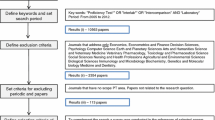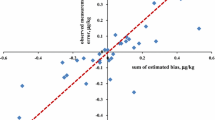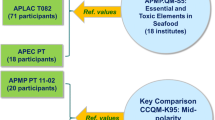Abstract
The importance of quality in analytical chemistry stimulates the development of different tools to assure the reliability of analytical results. Among different tools, proficiency testing (PT) stands out because it can be used to evaluate bias, check uncertainty, train analysts, or certify if a laboratory can execute a method adequately and provide correct results. There is a growing demand for traceable and reliable results in analytical chemistry, which can be illustrated with the growth of ISO/IEC 17025 accreditation and the importance of PT in this context. This has led to an increase in developments and publications about PT programs. This paper reports a detailed review considering the best practices to develop PT for chemical analysis, focusing on food and environmental matrices. An evaluation of the trends and the statistical strategies in its development in the last two years was performed to guide new developments of this tool that is increasingly necessary for laboratories.






Similar content being viewed by others
Availability of data and material
Not applicable.
Code availability
Not applicable.
References
Valcarável M, Rios A (1994) Analytical chemistry and quality. Trac Trends Anal Chem. https://doi.org/10.1016/0165-9936(94)85055-0
Olivares IRB, Lopes FA (2012) Essential steps to providing reliable results using the analytical quality assurance cycle. Trac Trends Anal Chem. https://doi.org/10.1016/j.trac.2012.01.004
Taverniers I, De Loose M, Van Bockstaele E (2004) Trends in quality in the analytical laboratory. II. Analytical method validation and quality assurance. Trac Trends Anal Chem. https://doi.org/10.1016/j.trac.2004.04.001
ISO/IEC 17025:2017 General requirements for the competence of testing and calibration laboratories. Geneva
OECD (1998) Series on principles of good laboratory practice and compliance monitoring—number 1: principles on good laboratory practice. Paris
ISO 15189:2015 Medical laboratories—requirements for quality and competence. Geneva
ILAC (2020) Facts and figures. https://ilac.org/about-ilac/facts-and-figures/. Accessed Mach 2020
Olivares IRB (2016) Laboratory quality management. Editora Átomo, Campinas
ILAC (2014) Policy for participation in proficiency testing activities. https://ilac.org/latest_ilac_news/ilac-p9062014-published/. Accessed Mach 2020
ISO 13528:2015 Statistical methods for use in proficiency testing by interlaboratory comparison. Geneva
ISO/IEC 17043:2010 Conformity assessment-general requirements for proficiency testing. Geneva
Zailer E, Monakhova YB, Diehl BWK (2018) 31P NMR method for phospholipid analysis in krill oil: proficiency testing-a step toward becoming an official method. J Am Oil Chem Soc. https://doi.org/10.1002/aocs.12153
Yeltepe E, Şahin NK, Aslan N, Hult M, Özçayan G, Wershofen H, Yücel Ü (2018) A review of the TAEA proficiency test on natural and anthropogenic radionuclides activities in black tea. Appl Radiat Isotopes. https://doi.org/10.1016/j.apradiso.2017.10.011
Yarita T, Otake T, Aoyagi Y, Takasaka N, Suzuki T, Watanabe T (2018) Comparison of assigned values from participants’ results, spiked concentrations of test samples, and isotope dilution mass spectrometric results in proficiency testing for pesticide residue analysis. J AOAC Int. https://doi.org/10.5740/jaoacint.17-0218
Esen AN, Haciyakupoglu S, Erenturk S (2017) Comparison of relative INAA and k0-INAA using proficiency test materials at ITU TRIGA Mark II research reactor. J Radioanal Nucl Chem. https://doi.org/10.1007/s10967-017-5669-0
Wiedner H, Riedl J, Maringer FJ, Baumgartner A, Stietka M, Kabrt F (2018) Production and characterization of a traceable NORM material and its use in proficiency testing of gamma-ray spectrometry laboratories. Appl Radiat Isotopes. https://doi.org/10.1016/j.apradiso.2017.09.025
Nakashima N, Duran EB (2018) Proficiency test exercises for particulate systems at CTBT radionuclide laboratories. Appl Radiat Isotopes. https://doi.org/10.1016/j.apradiso.2017.07.034
Stöckel S, Cordes J, Stoffles B, Wildanger D (2018) Scents in the stack: olfactometric proficiency testing with an emission simulation apparatus. Environ Sci Pollut Res. https://doi.org/10.1007/s11356-018-2515-z
Cordeiro F, Bratinova S, Karasek L, Buttinger G, Stroka J, Emteborg H, Seghers J, Robouch P, Emons H (2019) Can official control laboratories quantify reliably fipronil in eggs? Evidence from a proficiency testing round. Food Addit Contam. https://doi.org/10.1080/19440049.2019.1602885
Thompson M, Sykes M, Wood R (2019) Comparisons between reproducibility standard deviations (SDR) derived from proficiency tests and from collaborative trials: mycotoxins in food. Accred Qual Assur. https://doi.org/10.1007/s00769-019-01413-8
Dajay LC, Portugal TR, Climaco JC, Parcon MRV, Udarbe MA, Placio REE, Adona PE (2018) Establishment of proficiency testing programs in the Philippines. Accred Qual Assur. https://doi.org/10.1007/s00769-018-1363-3
Stefanelli P, Generali T, Girolimetti S, Barbini D (2018) Evaluation of the reproducibility standard deviation in the pesticide multi-residue methods on olive oil from past proficiency tests. Accred Qual Assur. https://doi.org/10.1007/s00769-018-1330-z
Thiex N, Carlson M, Kieffer R, Kieffer A, Eisenberg D, Bararshkov N, Ramsey C (2019) Evaluation of the use of microtracers™ in a proficiency testing program. J AOAC Int. https://doi.org/10.5740/jaoacint.18-0354
Aryana N, Ryana N, Ramadhaningtyas DP, Styarini D, Arisriawan Y (2019) First Indonesian proficiency testing using reference value from isotope dilution mass spectrometry method for benzoic acid, methyl paraben, and n-butyl paraben in sweet soy sauce. Accred Qual Assur. https://doi.org/10.1007/s00769-019-01398-4
Ferrini AM, Appicciafuoco B, Massaro MR, Galati F, Patriarca M (2019) Proficiency testing as an instrument to assess the analytical performance and the methods routinely implemented: the Italian experience for the screening of antibiotic residues in milk in the official control. Accred Qual Assur. https://doi.org/10.1007/s00769-018-1352-6
Kim H, Hwang E, Park J, Heo SW, Yim YH, Lim Y, Lim MC, Lee JW, Lee KS (2019) Proficiency testing for total mercury in oyster with a metrologically traceable reference value from isotope dilution mass spectrometry: implications on laboratory practices using mercury analyzers. Accred Qual Assur. https://doi.org/10.1007/s00769-019-01379-7
Ebarvia BS, Dacuya A, Cabanilla SR, Mamplata NR (2019) Provision of proficiency testing for histamine mass fraction in canned tuna to improve the capability of chemical laboratories in the Philippines. Accred Qual Assur. https://doi.org/10.1007/s00769-018-1347-3
Generali T, Stefanelli P, Girolimetti S, Barbini DA (2019) Results of the 16th proficiency test on the determination of pesticide residues in olive oil. Accred Qual Assur. https://doi.org/10.1007/s00769-018-1329-5
Middlebrook KA (2019) A proficiency testing scheme to evaluate the effectiveness of laboratory sample reduction of a soil sample. Accred Qual Assur. https://doi.org/10.1007/s00769-018-1357-1
Ziegler E, Tirard A, Boubetra A, Bort M (2019) Acquisition of stability data for pesticides in water sample through proficiency tests. Accred Qual Assur. https://doi.org/10.1007/s00769-018-1339-3
Coleman MD, Smith TOM, Robinson RA, Stoffels B, Wildanger D (2019) Combining UK and German emissions monitoring proficiency testing data based on stack simulator facilities to determine whether increasingly stringent EU emission limits are enforceable. Accred Qual Assur. https://doi.org/10.1007/s00769-018-1354-4
Krismastuti FSH, Hamim N (2019) Designing a formulation of synthetic wastewater as proficiency testing sample: a feasibility study on a laboratory scale. Accred Qual Assur. https://doi.org/10.1007/s00769-019-01399-3
Becker R, Sauer A, Bremeser W (2019) Fifteen years of proficiency testing of total petrol hydrocarbon determination in soil: a story of success. Accred Qual Assur. https://doi.org/10.1007/s00769-019-01383-x
Leyva MJB, Batidas PJ, Muñiz VR, Ceballos MSG, Ponce VG, Aguilera MD, Grajeda CP, Navidad MMS, Flores MME, Ramírez COJA, Aguilar ZG, Huerta BG (2019) Measurement of organochlorine pesticides in drinking water: laboratory technical proficiency testing in Mexico. Accred Qual Assur. https://doi.org/10.1007/s00769-019-01403-w
Olivares IRB, Souza GB, Nogueira ARA, Toledo GTK, Marcki DC (2018) Trends in devolpments of certified reference materials for chemical analysis—focus on food, water, soil and sedment matrices, trends in analytical chemistry. Trac Trends Anal Chem. https://doi.org/10.1016/j.trac.2017.12.013
EPTIS (2020) About the database. https://eptis.org/about.htm. Accessed May 2020
Baker M (2016) Is there a reproducibility crisis? Nature 533:452–454
Lisinger TPJ, Pauwels J, Van Der Veen AMH, Schimmel H, Lamberty A (2001) Homogeneity and stability of reference materials. Accred Qual Assur. https://doi.org/10.1007/s007690000261
ISO Guide 35:2017 Reference materials -- general and statistical principles for certification, 4th edition
Thompson M, Ellison SLR, Wood R (2006) The international harmonized protocol for the proficiency testing of analytical chemistry laboratories (IUPAC technical report). Pure Appl Chem. https://doi.org/10.1351/pac200678010145
RSC (2016) z-scores, and other scores in chemical proficiency testing—their meanings, and some common misconceptions. AMCTB. https://doi.org/10.1039/c6ay90078j
Fearn T, Thompson MA (2001) A new test for ‘sufficient homogeneity.’ Analyst. https://doi.org/10.1039/b103812p
Dixon WJ (1960). Simplified estimation from censored normal samples. Ann Math Stat. https://www.jstor.org/stable/2237953
Rivera C, Rodríguez R (2020) Horwitz equation as quality benchmark in ISO/IEC17025.TestingLaboratory. Available at: https://pdfs.semanticscholar.org/d6d6/a38d1a9e01e526ca4e2b5b8d804670e5414f.pdf?_ga=2.149818485. 2108515611.1564572314–1074601812.1564572314. Accessed 30 July 2020
Horwitz W (1982) Evaluation of analytical methods used for regulations of food and drugs. Anal Chem. https://doi.org/10.1021/ac00238a765
Acknowledgements
We acknowledge financial support from the São Paulo State Research Foundation (FAPESP, 2020/01238-4, 2018/26145-9) and the National Council for Scientific and Technological Research (CNPq, grant 308178/2018-1).
Funding
Not applicable.
Author information
Authors and Affiliations
Corresponding author
Ethics declarations
Conflicts of interest
The authors declare that they have no conflict of interest.
Ethics approval
Not applicable.
Consent to participate
Not applicable.
Consent for publication
Not applicable.
Additional information
Publisher's Note
Springer Nature remains neutral with regard to jurisdictional claims in published maps and institutional affiliations.
Rights and permissions
About this article
Cite this article
Olivares, I.R.B., de Souza, G.B., de Araujo Nogueira, A.R. et al. Trends in the development of proficiency testing for chemical analysis: focus on food and environmental matrices. Accred Qual Assur 27, 55–83 (2022). https://doi.org/10.1007/s00769-021-01487-3
Received:
Accepted:
Published:
Issue Date:
DOI: https://doi.org/10.1007/s00769-021-01487-3




